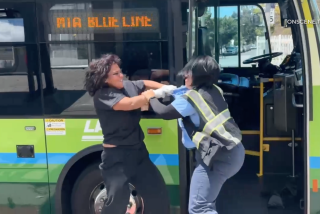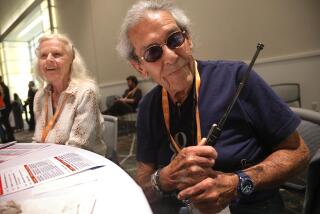RTD Begins Drive to Improve Its Image : Transportation: A survey shows that Valley commuters had a higher disapproval rate of bus service than others.
- Share via
The Southern California Rapid Transit District has launched a campaign to combat a problem for its bus lines that may be harder to wipe out than graffiti: the image held by many commuters that buses are slow, inconvenient, crime-plagued and reserved primarily for the poorer classes.
The perception exists to some degree in all RTD service areas, but a new survey indicates that it is strongest in the San Fernando Valley.
Transit officials say they will look for a consultant this month to help reorganize routes in the Valley, and also plan to add new services and air television spots promoting the district’s police department.
One RTD official even suggested--partly in jest--borrowing an auto maker’s slogan to get commuters to reconsider the service. “This is not your father’s RTD bus,” quipped Gary Spivak, RTD assistant general manager of planning and public affairs.
“There is no question that the RTD, to some people, is still the transportation mode of last resort,” RTD Director Nikolas Patsaouras said. “But I believe we are making headway. Once people try us, they will be surprised.”
Nearly half of those surveyed in two large areas of Los Angeles County, whether they ride the bus or not, held a generally positive opinion of RTD bus service. But Valley residents had a higher disapproval rate than their counterparts in what was called the Mid-Cities area, including such communities as Huntington Park, Whittier, Montebello, Vernon, Lynwood and Norwalk.
In the Valley, four of every five bus riders don’t have access to a car, meaning that they have few transportation alternatives, according to the survey. The challenge, transportation officials say, is for the RTD to appeal to those commuters who own cars and routinely drive to work.
Of those Valley commuters who don’t take the bus, 36% rated the bus service highly, while 44% said the service was adequate, according to the survey. The remaining 20% perceived the service as poor or unfavorable--contrasted with just a 14% disapproval rating among non-riders in the Mid-Cities area, according to the survey.
The most frequent complaints by riders and non-riders alike were that buses don’t run frequently enough and don’t go to their desired destinations.
At a busy stop in Sherman Oaks, Julie West, 26, waited in the rain for her bus to Westwood, where she works for an insurance company. A regular bus rider for two years, West said she doesn’t mind the wait, which for her varies from 15 minutes to half an hour. What bothers her are the RTD drivers.
“I don’t think they like their jobs, so they are grouchy,” she said. “I don’t like my job, but I have to be nice to everyone.”
She was not alone in her opinion. According to the survey, 19% of Valley riders and 16% of Mid-Cities riders said bus drivers were rude or unfriendly, don’t respect senior citizens, slam doors on passengers, drive recklessly and won’t answer questions.
On a bus trip along Ventura Boulevard in Sherman Oaks, an elderly woman complained when the driver refused to stop a few yards before the next bus stop to avoid a huge puddle of rainwater.
“In Minnesota, the bus drivers are a little more courteous,” she said as she stepped off the bus.
“Well, why don’t you go back to Minnesota?” the driver replied.
But at the next stop, the driver jumped to his feet to help a woman who had slipped on the steps of the bus.
“Everyone be careful with this step; it’s wet,” he shouted.
Kevin Baker, 41, a video technician from Sherman Oaks who has taken the bus to work for about a year, had no major complaints.
“For the most part, they maintain it well,” he said. “They do the best they can with what they have.”
Among other survey results:
* 7% of Valley riders and 22% of Mid-Cities riders were concerned about safety on the bus.
* 82% of Valley riders and 67% of Mid-Cities riders do not own or have access to a car.
* 8% of Valley riders and 22% of Mid-Cities riders rated the bus fares as unreasonable.
* 15% of Valley riders and 62% of Mid-Cities riders use some other form of public transit besides the RTD.
* 78% of Valley riders and 69% of Mid-Cities riders said their complaints can be easily addressed by the RTD.
* 41% of business leaders in both areas considered RTD a poor transportation alternative, while only 23% considered it an “excellent to very good” alternative.
Statistics provided by RTD officials show that ridership numbers have increased over the past three years by about 22% in the Mid-Cities area; the increase has been 10% in the Valley.
The survey, completed in the fall by a private firm hired by the RTD, included interviews in English or Spanish with 1,004 non-riders and 1,155 RTD patrons, and focus groups of business leaders. The Valley and Mid-Cities areas were selected because they represent large segments of the RTD service area.
Transportation officials said most of the planned improvements for bus service in the Valley were initiated before the survey was completed, but that the results reinforced their convictions that the area needs upgraded service.
“I ride the bus a lot myself,” said Los Angeles County Transportation Commissioner Jim Tolbert, a Van Nuys resident who also sits on the RTD board of directors. “I just think that the Valley seems to be underserved as opposed to other parts.”
Members of the survey’s focus groups said buses and taxis topped their list of the “worst form of transportation.” They rated rail mass transit as best, describing it as fast, effective, clean and independent of automobile traffic.
Spivak said he understands why most people rate rail transportation “one notch above the regular bus.”
“What would you rather do--step on a platform and wait for a nice shiny train, or stand on a street corner and wait for a bus?” he said. “It’s all psychology.”
Along those lines, the survey quoted a focus group member as saying that riding the bus is perceived as “not the fashionable thing to do--since everyone else is driving.”
Another focus group member, an employer, noted that some workers have a low opinion of people who ride the bus.
“It’s a class thing. They think that lower-class people ride the bus. . . . It’s not true, but that’s the consensus.”
RTD officials said they are hoping to change such perceptions.
They have been meeting for the last year with business leaders to encourage them to promote bus commuting among their employees, Spivak said, in part by selling discounted bus passes at the workplace. The RTD also offers, for a fee, to draw up itineraries for the workers, showing the fastest bus route to get to work, how much it will cost and how long the trip will take.
Patsaouras said the RTD will advertise soon for the consultant to study restructuring routes in the Valley in hopes of increasing bus frequency and positioning bus stops so that riders can more easily hook up with other forms of public transportation, such as shuttle buses and taxis. The present bus system was designed in the late 1970s and needs to be updated to serve the new population centers and work sites, he said.
To combat the perception of crime problems on buses, Spivak said, the district will air television commercials in the next few months to promote the RTD’s police force, which has 198 officers.
The district is also considering a computerized system that would pinpoint the location of any RTD bus so that police can more quickly respond to problems, he said. Transportation officials now locate buses through radio communications and route schedules, he said.
Another part of the battle against negative images is keeping buses free of graffiti, Spivak said, noting: “If you ride a bus that has been hit by one of these tagger gangs, you don’t feel as comfortable.”
Spivak said the RTD would like to spend more money on new buses but is strapped for funds. Despite a $42-million deficit, officials have vowed not to cut services or raise fares.
Most of the improvements mentioned by Spivak and Patsaouras are in line with the recommendations made by Maritz Marketing Research Inc., which conducted the survey.
The firm suggested that the RTD expand bus routes, run buses more frequently, educate the public on bus safety measures and increase promotions of special bus services provided through employers.
More to Read
Sign up for Essential California
The most important California stories and recommendations in your inbox every morning.
You may occasionally receive promotional content from the Los Angeles Times.











